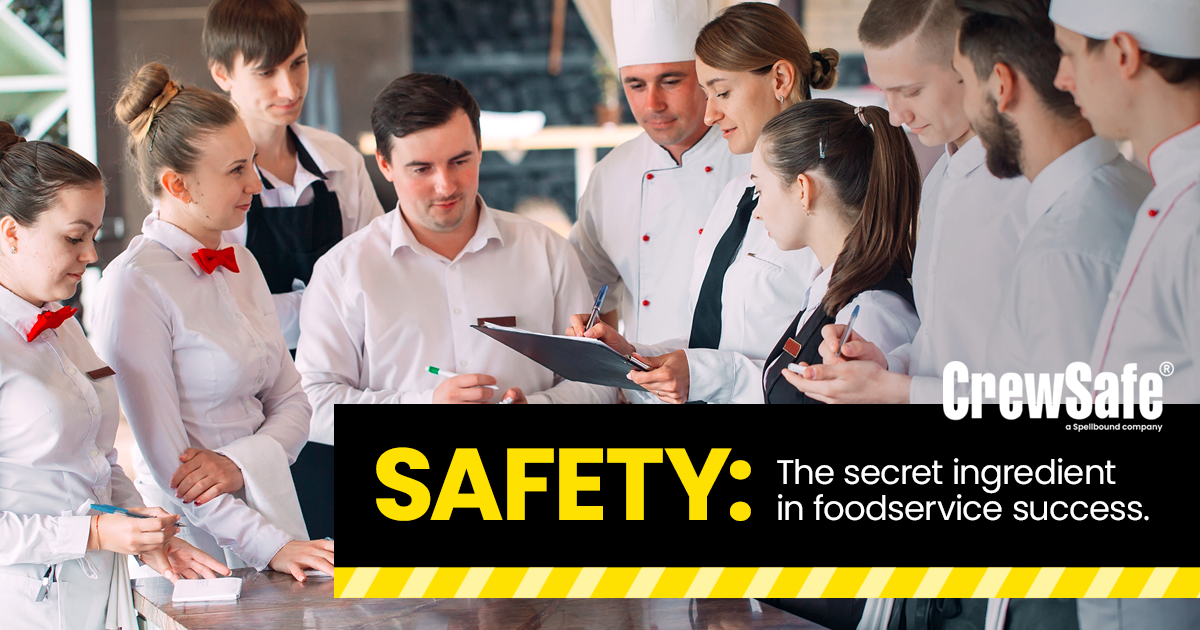When it comes to foodservice operations, most think about catering to the customers, but we should also be putting safety on a silver platter for employees. No matter the industry, a strong workplace safety culture is essential to keep business thriving.
With the American foodservice industry employing more than 2.2 million servers, 1.3 million cooks, and 711,140 bartenders, safety is a component that can’t be compromised.
Incorporating a strong safety culture within foodservice settings protects employees from injuries while enhancing customer satisfaction by minimizing the risk of foodborne illnesses and contamination. Safety culture refers to the collective practices, beliefs, and attitudes within an organization that emphasizes the importance of safety in the workplace.
Camille Chavez, vice president of training and development at Black Bear Diners, walks us through what safety culture looks like within their operation and how leadership integrates innovative techniques to help:
- Enhance efficiency
- Reduce costs
- Strengthen employee morale
Taking the lead
Leadership sets the tone of safety culture in the workplace. Without a strong leadership team valuing employees as humans first and workers next, safety is just another buzzword.
“Leadership is all about ensuring safety by consistently communicating the ‘why’ — that we value our employees and their safety — before teaching the ‘how’ of safe practices,” Chavez said.
Effective leadership surrounding safety includes:
- Transparency
- Consistency
- Reinforcement
- Leading by example
For Black Bear Diners, safety starts with new hires and continues to be ingrained into employees as they continue their careers in the company.
By establishing a priority around safety from the beginning, leaders set the expectations for each employee’s time at the company.
Leaders can stay present by:
- Participating in safety training alongside employees
- Engaging in safety briefings
- Conducting on-the-spot safety checks
Safety vs. business
What’s more important: safety, or a business’s productivity and profitability? If you haven’t guessed already, the answer is both!
It’s important to find the balance between safety and all other business priorities. The key is to not pigeonhole safety into a box but integrate it into all parts of the business.
“The most successful managers are those who interweave safety practices into everything they do,” Chavez said. When businesses incorporate safety into daily practices, they can achieve goals while creating a safe working environment.
Empowering employees
When curating safety in the workplace, active employee participation is key. Black Bear Diners incorporates safety training into new-hire orientation, monthly safety training, and online certifications to promote employee engagement.
With leadership-led initiatives, managers can provide feedback and coaching to their employees, offering a hands-on approach in real time to ensure safety practices, and followed and integrated into an employee’s daily routine.
Encouraging employees to take the initiative in safety fosters a proactive workplace safety culture. For example, having staff participate in safety walkthroughs alongside managers to identify potential safety hazards empowers employees to take ownership while reinforcing safety protocols.
According to Chavez, the more they involve team members, the more buy-in they get, making safety a shared responsibility across the operation.
Encountering resistance
Incorporating a productive safety culture into your foodservice operation seems simple, right? Unfortunately, that’s not the reality.
Resistance to safety culture is a common challenge in the workplace since some see certain practices as unnecessary. One way to combat resistance is by building habits that become second nature. This includes reinforcing safety practices until they become part of an employee’s daily routine.
“It has to become second nature, a consistent reminder from leaders, and written into all the procedures and SOPs,” Chavez said. This approach helps prevent accidents and ensures employees understand how essential safety is before an incident happens.
Effective safety training programs
Since every person’s learning style is different, an effective safety training program should engage through:
- Interactive courses or videos
- Real-world scenarios
- Continuous learning
With the evolving foodservice industry, it’s essential to keep up with safety standards and regulations through regular updates to training content. This guarantees employees stay current with the latest knowledge.
Maintaining safety standards can include:
- Leveraging industry reports
- Incorporating new safety technologies
- Revising training materials to reflect current best practices
What about incentives?
Incentive programs can positively impact employee behavior, but if not carefully monitored, these programs can lead to consequences including underreporting.
When done correctly, an incentive program is a powerful tool that rewards employees for contributing to the safety culture, but it must promote a commitment to safety versus compliance.
Incentives can include:
- Bonuses
- Recognition programs
- Additional PTO
Making safety stick
Safety should be at the core of workplace culture, influencing every component of the operation. As we mentioned before, transparency and consistent communication regarding safety can help this core value be seen as an overall business goal and not a separate initiative.
How to improve safety culture
Continuous improvement is key to maintaining a strong safety culture.
Strategies include:
- Safety audits
- Employee feedback
- Updated safety protocols
By incorporating employee feedback and other tactics, businesses can make improvements that positively impact employees, leading to a culture where safety is prioritized.
A firm safety culture within foodservice operations must include active leadership commitment, empowered employees, current and effective training, and the integration of safety into workplace culture.
Keeping it safe with CrewSafe
CrewSafe provides safety solutions that can be integrated into foodservice operations, helping businesses foster a safety culture that protects customers and employees.
With solutions including CrewSafe’s safety poster program, foodservice operations can incorporate fun, innovative ways to help employees focus on safety.
If your operation wants to approve a safety culture, contact CrewSafe for expert guidance on which solutions will best benefit your safety culture.

